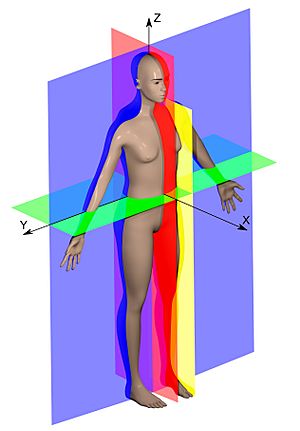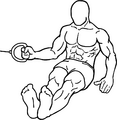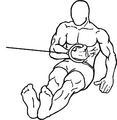Adduction facts for kids
Adduction is a type of movement in your body. It happens when you move a part of your body closer to the middle line of your body. Think of it like bringing your arm down to your side after you've lifted it up. The opposite movement is called abduction, which is when you move a body part away from the middle line.
Contents
How Your Body Moves: Adduction
Muscles are what make your body move. Adduction is controlled by many different muscles throughout your body.
Moving Your Arms
When you lower your arm from being out to the side, you're using adduction at your Shoulder. Some of the muscles that help with this are:
- Subscapularis
- Teres major
- Pectoralis major (your chest muscle)
- Infraspinatus
- Triceps brachii (a muscle at the back of your upper arm)
- Latissimus dorsi (a large muscle in your back)
- Coracobrachialis
Your Hand can also perform adduction at the Wrist. This moves your hand closer to the middle of your body. The muscles involved include:
- Flexor carpi ulnaris
- Extensor carpi ulnaris
Even your Fingers can adduct, which means they move closer together. The muscles for this are:
- Palmar interossei
Your Thumb has a special muscle just for adduction, bringing it closer to your palm:
- Adductor pollicis
Moving Your Legs
When you bring your Thigh closer to your other leg, or cross your legs, you're using adduction at your Hip. A group of muscles called the adductor muscles help with this:
- Adductor longus
- Adductor brevis
- Adductor magnus
- Pectineus
- Gracilis
Your toes can also adduct, moving closer together. The muscles for this are:
- Adductor hallucis
- Plantar interossei
Other Body Parts
Adduction isn't just for arms and legs! Other parts of your body use this movement too:
- Your vocal folds (in your throat) move together (adduct) when you speak or sing.
- Lateral cricoarytenoid muscle
- Your eyeball can also move towards the middle of your face (adduct).
- Superior rectus muscle
- Inferior rectus muscle
- Medial rectus muscle
Adduction in Scallops
It's not just humans and land animals that use adduction! Scallops, which are a type of bivalve (like clams or oysters), have a very strong adductor muscle. This muscle lets them quickly open and close their shells. Because scallops can swim by rapidly opening and closing their shells, their adductor muscle is much larger and more developed than in other bivalves that don't swim as much.
Images for kids
-
The lotus position of yoga, demonstrating external rotation of the leg at the hip.
-
The swinging action made during a tennis serve is an example of circumduction
-
A ballerina, demonstrating plantar flexion of the feet
-
Praying Hands by Albrecht Dürer, demonstrating dorsiflexion of the hands.




















